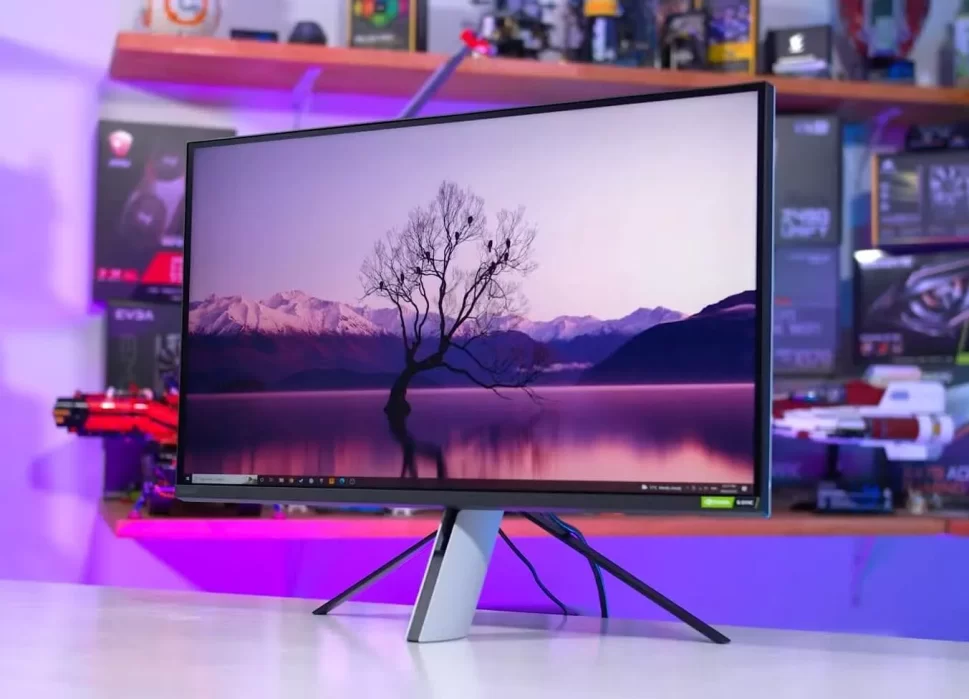The design of this Inzone M9 (starting now, we will use the abbreviated formula used by Sony to identify this screen) is inspired by PlayStation 5. And yes, as we will see later, this monitor has been designed to coexist with this video game console but is equally comfortable on a PC. It hides an ace up the sleeve that allows it to offer us a fantastic experience when we connect it to a computer.
Its adjustment software for Windows is fabulous.
Sony gives us this impeccably calibrated monitor from the factory. Screens explicitly designed for content creation, photo retouching, and video editing sound well calibrated, but gaming monitor settings often require time to spend if you want to get the most out of them. It is not the case. I have hardly had to fine-tune the image parameters to leave them as I like and I think it solves the colorimetry more precisely.
In any case, and this is one of the points in favor of this more solid monitor, Sony provides us with an application called Inzone Hub from which we can act on its behavior intuitively. We can activate the adaptive refresh, minimize the response time, work on the gamma correction, manipulate the behavior of the FALD backlight, and adjust the hue… Everything. Of course, this software is only available for Windows 10 and 11, not for macOS.
On the other hand, the OSD menu implemented on the monitor itself is up to the task. From here, we can also act on continuous adjustments that condition both the image quality and the gaming performance of this monitor. However, I think it is more comfortable to do it from the Inzone Hub software.
From the OSD menu, we can act on continuous adjustments that condition both the image quality and the performance of the games on this monitor.
To scroll through the options in this menu, we have to use a small joystick on the back of the monitor. It’s the same solution that most manufacturers opt for, and it works fine, so I have no objections.
The connectivity of some of the monitors I’ve reviewed over the past few months has left me wanting more, but Sony has also done its homework in this area.
Sony has carefully resolved the connectivity of this monitor. And it’s a hit.
And it is that this Inzone M9 incorporates two HDMI inputs that implement the 2.1 standards, a DisplayPort 1.4 input, a USB type C port with a power delivery capacity of up to 15 watts, three USB type A ports, and the always well-received 3.5mm jack to allow us to connect our wired headphones.
Integrating a second DisplayPort input would not have been a bad idea, but it is a trifle that does not tarnish well-resolved connectivity.
This foot is a delight if you want to save space on your desk.
As I have anticipated in the first lines of this analysis, the influence of the PlayStation 5 design on the aesthetic commitment of this monitor is very evident. Its frames are thin, and the enclosure containing the panel is made of a good quality rigid polycarbonate, so I have nothing to object to.
To find similarities between the design of this screen and that of the latest Sony desktop console, we have to look at the foot responsible for guaranteeing the stability of the panel. When you look at it from the front, from the natural position from which we look at the monitor, it is reminiscent of the PS5 design. However, the innovative ingredient that makes this foot is only appreciated if we look at it from behind.
In the following photograph, we can see the two metal rods that come together in the central column of the foot to give the monitor the stability it requires if we give it an accidental push. This fastening system fulfills its mission perfectly, but it also has an advantage that we cannot overlook: the space that this foot occupies on our table is minimal.
When we look at the monitor from the front, the rods go unnoticed, and it seems that the panel is only supported by the central column.
Also, the rods extend toward the monitor’s rear and not toward the front, so they do not take up space in our table where we usually place the keyboard, mouse, and other peripherals. Sony has also been successful in painting them black because when we look at the monitor from the front, they go unnoticed, and it seems that the panel is only supported by the central column.
The foot that Sony engineers have developed for this monitor allows us to adjust the panel’s height in a range of up to 70 mm and its inclination between 0 and 20 degrees, but we cannot pivot or rotate it. And I miss these two additional adjustment options because it is likely that some users would have helped them find the optimal setting from an ergonomic point of view.
Its image quality is outstanding and is unusual for a gaming monitor.
To analyze the image quality of this monitor, I turned to Eizo Monitor Test, a handy free tool not only to check how a display device resolves color but also what its viewing angles are, if its sharpness is up to par, if the backlight is wholly homogeneous or if it has a defective pixel, among other benefits.
The following picture of the panel of this screen was taken using my digital microscope, and in it, we can see very clearly the distribution of the RGB sub-pixels of the IPS-type LCD matrix. The anti-glare coating that Sony has introduced in this monitor is not infallible, as we will see later. Of course, it hardly blurs the sub-pixel matrix, something that other more aggressive anti-reflection coatings do.


